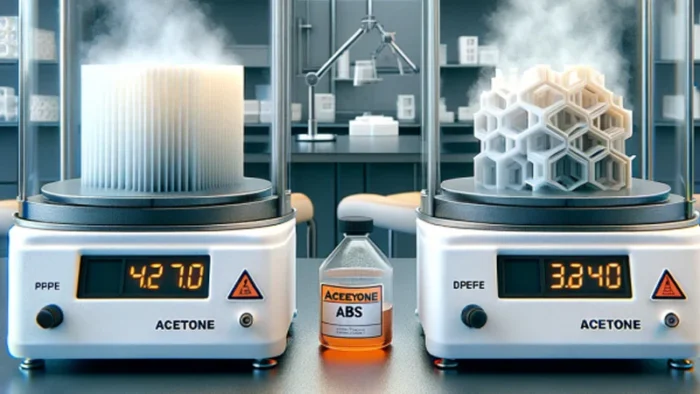Vapor Smoothing Finishing: Revolutionizing the 3D Printing Post-Processing World
In the world of 3D printing, post-processing plays a crucial role in achieving a professional finish and improving the overall aesthetics and functionality of a printed object. Among the various post-processing techniques, vapor smoothing is gaining popularity for its ability to smooth out the rough, uneven surfaces often seen on 3D-printed models. It’s not just about looks; this method can also enhance the material properties of the printed objects, leading to stronger and more durable prints.
But what exactly is Vapor Smoothing Finishing, and why is it becoming the go-to solution for enhancing 3D printed parts? Let’s dive into this innovative finishing process and explore how it’s changing the game for 3D printing enthusiasts, designers, and manufacturers alike.
What is Vapor Smoothing?
Vapor smoothing is a post-processing technique used to refine the surface of 3D printed parts, specifically those printed with thermoplastic materials such as ABS (Acrylonitrile Butadiene Styrene) and ASA (Acrylonitrile Styrene Acrylate). The process involves exposing the printed part to a solvent vapor that interacts with the surface of the material, softening it. This softening effect causes the rough, jagged edges of the print to melt slightly, resulting in a smoother, glossy finish.
This technique is particularly useful for FDM (Fused Deposition Modeling) prints, which often have visible layer lines due to the nature of the extrusion process. These layer lines can detract from the visual appeal of the print, as well as cause structural weaknesses in the part. Vapor smoothing helps eliminate these imperfections, making it a favored choice for creators looking to enhance their prints.
How Does Vapor Smoothing Work?
Vapor smoothing works through a chemical interaction between the solvent vapor and the thermoplastic surface of the printed object. Here’s a breakdown of the process:
- Preparation: After the 3D print is complete, the object is carefully placed inside a closed chamber that contains the solvent. The most commonly used solvent for vapor smoothing ABS is acetone. The solvent evaporates inside the chamber and creates a saturated vapor environment.
- Exposure: The object is exposed to the solvent vapor for a predetermined amount of time. The vapor gently reacts with the outer layers of the print, softening the surface.
- Smoothing: As the solvent interacts with the material, the outer layer of the print begins to smooth out. The layer lines that were previously visible start to merge and fade away, resulting in a sleek and shiny surface. The time of exposure and the distance between the object and the solvent vapor determine the extent of the smoothing effect.
- Drying: After the exposure, the print is allowed to dry, and the solvent evaporates. The object should then feel much smoother to the touch, with a glossy finish and no visible layer lines. The surface may also be more resistant to wear and tear.
Benefits of Vapor Smoothing
The advantages of vapor smoothing extend beyond just the aesthetics of 3D-printed parts. Here’s a look at some of the key benefits:
1. Enhanced Surface Finish
One of the most notable benefits of vapor smoothing is its ability to deliver a high-quality, professional finish. The solvent gently melts the outer layers of the print, eliminating rough edges and visible layer lines. The result is a smooth, glossy surface that mimics the appearance of injection-molded parts. This is particularly important for applications where the visual quality of the print is essential, such as in product prototypes, models, and consumer-facing products.
2. Improved Material Properties
Vapor smoothing doesn’t just improve the look of a print; it can also enhance its mechanical properties. By softening the outer layer, the process can help to reduce brittleness and increase the overall strength of the part. This is especially beneficial for objects that are going to be subjected to stress or load, as it can improve their durability and longevity.
3. Reduced Post-Processing Time
Compared to other post-processing techniques like sanding or polishing, vapor smoothing is much faster and more efficient. Sanding can be time-consuming, especially for complex shapes, while vapor smoothing takes a relatively short amount of time to achieve a smooth finish. This makes it an ideal choice for creators who need to quickly and effectively improve the appearance of their prints.
4. Less Labor-Intensive
Traditional finishing methods, like sanding and polishing, require significant manual effort and skill. In contrast, vapor smoothing is a more automated process, allowing the operator to focus on other tasks while the object is treated. This can save valuable time and reduce the potential for human error, making it an attractive option for high-volume production environments.
5. Better Adhesion for Subsequent Coatings
Vapor smoothing also helps create a more uniform surface, which can improve the adhesion of paint, adhesives, or other coatings. For instance, if a designer wants to apply a color coating or protective layer, the smoother surface will help the coating adhere more evenly, resulting in a more durable and professional finish.
Materials Suitable for Vapor Smoothing
While vapor smoothing is most commonly associated with ABS, it can also be used on other thermoplastics that exhibit similar chemical properties. Some of the materials that are commonly treated with vapor smoothing include:
- ABS: The most commonly vapor-smoothed material, as it readily reacts with acetone.
- ASA: This material is similar to ABS but offers better UV resistance, making it suitable for outdoor applications.
- Polycarbonate (PC): Some formulations of polycarbonate can also be vapor-smoothed using specialized solvents.
- PETG (Polyethylene Terephthalate Glycol): Some users have reported success with vapor smoothing PETG, though it requires more specific conditions.
Not all materials are suitable for vapor smoothing. For example, PLA (Polylactic Acid) does not respond to acetone vapor in the same way as ABS, and it is generally not recommended for this process. It’s important to check the compatibility of your material before attempting vapor smoothing.
Safety Considerations
While vapor smoothing can yield excellent results, it’s essential to follow safety guidelines. The solvents used in this process, such as acetone, are highly flammable and should be handled with care. Proper ventilation is crucial to avoid inhaling fumes, and a well-ventilated, enclosed chamber is typically used to minimize exposure. Always wear protective gear, such as gloves and goggles, when working with solvents.
Conclusion
Vapor smoothing is a game-changing post-processing technique for 3D printing, offering significant improvements in surface finish, material properties, and time efficiency. Whether you’re a hobbyist looking to enhance the quality of your prints or a manufacturer aiming for professional-grade results, vapor smoothing is a highly effective method for elevating the appearance and performance of your 3D printed objects.
By reducing the visible layer lines and improving the strength of the print, vapor smoothing is helping to push the boundaries of what 3D printing can achieve, making it a valuable tool for both creative and industrial applications. As the technology continues to evolve and more materials become compatible with vapor smoothing, it’s clear that this technique will play a vital role in the future of additive manufacturing.






